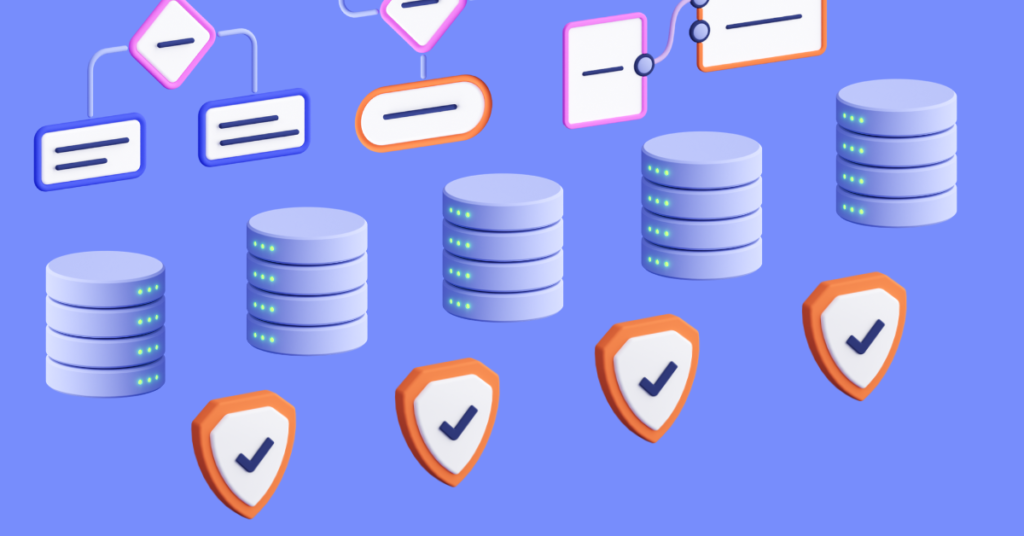Enterprise data is one of the most important assets a company has. It contains information about customers, products, and business processes. Protecting sensitive data should be a top priority for companies, since the theft of that data can cause tremendous financial and reputational damage.
This article discusses strategies for protecting your enterprise data by preventing and mitigating breaches before data can be lost or stolen.
Top 4 Types of Data Protection for Enterprise Businesses
Data protection for enterprise businesses consists of four parts – Assessment, Governance, Training, and Response.
Assessment
Even if you have covered your governance, training, and response needs, your efforts to protect data will fail without regular, structured assessment. The first goal of assessment is to identify what data needs protection and where that data lives in your network. Then, as training and procedures are implemented, an assessment will be used to determine if your efforts have been successful. Finally, assessment metrics measure risk as part of your ongoing security checks and controls.

Governance
Governance refers to the framework of policies and procedures that guide your cybersecurity practice. By developing a standardized framework for response and mitigation, you ensure that all stakeholders understand the necessary tasks and behaviors.
Training
Once you have decided on your policies, procedures, and assessment strategy, it’s time to train your employees. Employees are the end-users of your organization’s security strategy, making them an attractive target for cybercriminals. Your employees have access to sensitive data and may access that data via unsecured devices. Educating your employees to recognize and report potential attacks maximizes data protection for your enterprise.
Response
The fourth piece of a comprehensive enterprise data protection strategy is your response. The truth is, despite your best efforts, you will almost certainly experience a data breach eventually. That’s why you must develop a cybersecurity incident response plan that ensures business continuity and provides a strategy for containment and mitigation.
Your incident response plan must include a framework for investigating the cause and impacts of a data breach, notification of impacted stakeholders, preservation of data, and remediation of the breach.
Principles of Enterprise Data Security
While each enterprise holds different data in different ways, some fundamental principles can be applied to enterprise data security strategy for all companies.
Inventory all data assets held by your enterprise
Data is one of an enterprise company’s most important assets. Businesses use it to make informed decisions, and it needs to be kept safe and secure. However, many organizations don’t understand what data they hold or where it’s stored. This can lead to data breaches and other security incidents. To protect your data effectively, you must understand what information you hold as well as where and how it’s stored. Data inventory isn’t only about data protection either; data storage practices are governed by regulations and failing to keep track of data storage can result in compliance failures.

Identify business-critical data and control access
Retaining only integral data is the most crucial data security policy. Organizations should keep data only if it’s for a legitimate business need and only for as long as it is needed.
Companies broaden their attack surface when confidential employee or customer data is stored and used unnecessarily. Minimizing the types of data held by the enterprise company can considerably lower the risk of exposure, reducing the potential impacts of a breach.
Dispose and destroy obsolete data properly
Now that you’ve decided what data your enterprise should store and what should be discarded, you need to ensure that your obsolete data is discarded appropriately. In addition, employees need to know that it takes more than just moving documents to their trash folder. Endpoint monitoring tools like Teramind give visibility into how files are handled, letting you supervise file transfers to ensure that data is disposed of correctly.
Safeguard stored information
There are three main aspects of enterprise data protection strategy, and all three must be addressed to protect enterprise data – physical security, electronic security, and training.
Physical Security
Physical security of data involves the secure handling of paper documents. It sounds simple, but it can be hard to get right. In fact, many enterprise companies don’t have a formal policy for the disposal of paper documents, which creates just the right conditions for sensitive information to be stolen or exposed.
Electronic Security
Each device on your network has its own unique vulnerabilities, from your on-site computers to employees’ mobile devices. With Teramind endpoint monitoring, you can manage all aspects of electronic security. For example, with eyes on user activity on every network-connected device, you can monitor for inappropriate or suspicious user behavior.
Employee Training
Your end-users can be your greatest vulnerability if you don’t train them to recognize the warning signs of an attack. Educating your users on how to identify an attack in progress and what to do if they think they are being attacked can help to prevent a successful cyberattack. Users should be aware of the common warning signs of an attack, such as strange emails or websites, unexpected pop-ups, and unusual behavior from software programs.
Create a security breach response plan
An incident response plan is essential for maintaining business continuity by providing a pathway to mitigating breaches. For example, IBM’s 2022 Cost of a Data Breach Report found that organizations with a well-tested incident response plan saved on average USD 2.66 million per breach.
10 Ways Large Enterprises Protect Their Data
Protect enterprise data by adopting these ten best practices. Combined they provide a well-rounded cybersecurity strategy but individually each method bolsters security practices in their own way.
Train employees
Cybercriminals like to exploit weaknesses in your security practices, and many times all they need are mundane methods like phishing. Keeping your employees educated about cyber-related risks and threats is essential to ensure they know how to recognize an attack.
Cybersecurity training for employees shouldn’t stop there, however. Provide all employees with the policies and procedures you rely on to keep data secure and make sure they understand the vital role that they have to play in your incident response plan. Consistent employee training is necessary to reinforce good data security practices and keep employees up to date about current attack methods and indicators of compromise.
Data backup
Backing up enterprise data ensures ongoing access in the event of a breach, allowing you to maintain business continuity. Data should be backed up frequently to enable easy restoration of corrupted or compromised data. Data backups should be stored in a secure place, whether it is an off-site server or physical vault.
File transfer monitoring
Unusual traffic on your server can be an essential indicator of compromise. A comprehensive endpoint monitoring tool like Teramind keeps track of user activity. If suspicious file transfers occur, the tool will use notifications to advise you that a potential problem has occurred, giving you an early warning so you can close the breach and prevent further damage.
Destroy unneeded data
Develop procedures for adequately destroying data and hold employees accountable for following the processes. Data storage devices should be considered valuable company assets. Obsolete devices such as hard drives or thumb drives should be wiped or otherwise scrubbed to ensure that no sensitive data remains before it is disposed of.
Portable device security
Mobile device security is a real challenge for enterprise data protection. Your cybersecurity strategy should consider the vulnerability of each device accessing your network. In addition, you should provide employees with the knowledge and tools necessary to secure data access via mobile devices.
Encryption
The number of data breaches is on the rise. To protect your data, you should encrypt it. Encryption transforms readable data into an unreadable format, which can stymie a hacker and prevent them from scoring an easy win. This can be done with a password or key. If your data is encrypted, attackers will find it much more difficult to access or use.
Principle of least privilege
Enterprise companies hold vast amounts of sensitive data, from vendor information to payroll data. To keep your data safe, exercise the principle of least privilege. The principle of least privilege stipulates that you limit employee access to sensitive data to only those who need it to perform their job functions.
Install security updates and patches
Zero-day exploits are another popular method for cyber attackers. One of the best ways to protect your computer from a data breach is to keep your security patches and updates current. By doing this, you close any security loopholes that may exist on your computer. However, when you snooze security alerts and don’t install them in a timely fashion, you leave your networks vulnerable to known threats and exploits.
Third-party vendors
Third-party vendor security has recently been thrust into the spotlight as major data breaches continue. Despite increased awareness and investment in security measures, holes in vendor security continue to lead to significant data breaches. One of the first steps in managing third-party vendor security is being selective about which vendors you choose. You should adequately vet their security practices to ensure that your data will be secure in their keeping.
Endpoint monitoring
One of the benefits of endpoint monitoring is that it provides real-time alerts if a device on your network is compromised. This allows you to take immediate action to protect your data.
Endpoint monitoring is tracking and managing devices that connect to your network. By using endpoint monitoring tools, you can detect and prevent data breaches that rely on compromising endpoints and devices to gain access. Beyond this, endpoint monitoring protects systems against vulnerable user behaviors that result in data breaches, whether intentional or accidental.
Conclusions
In conclusion, while no cybersecurity strategy is foolproof, a comprehensive approach is your best bet for defending your enterprise against cyberattacks. Remember to keep your systems and software up to date, train your employees on security protocols, and create a plan for responding to incidents. With diligence and planning, you can help reduce the risk of a costly and damaging cyberattack.
Protect Enterprise Data Through Behavior Analytics



